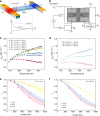Far-field coherent thermal emission from polaritonic resonance in individual anisotropic nanoribbons
- PMID: 30914641
- PMCID: PMC6435684
- DOI: 10.1038/s41467-019-09378-5
Far-field coherent thermal emission from polaritonic resonance in individual anisotropic nanoribbons
Abstract
Coherent thermal emission deviates from the Planckian blackbody emission with a narrow spectrum and strong directionality. While far-field thermal emission from polaritonic resonance has shown the deviation through modelling and optical characterizations, an approach to achieve and directly measure dominant coherent thermal emission has not materialised. By exploiting the large disparity in the skin depth and wavelength of surface phonon polaritons, we design anisotropic SiO2 nanoribbons to enable independent control of the incoherent and coherent behaviours, which exhibit over 8.5-fold enhancement in the emissivity compared with the thin-film limit. Importantly, this enhancement is attributed to the coherent polaritonic resonant effect, hence, was found to be stronger at lower temperature. A thermometry platform is devised to extract, for the first time, the thermal emissivity from such dielectric nanoemitters with nanowatt-level emitting power. The result provides new insight into the realisation of spatial and spectral distribution control for far-field thermal emission.
Conflict of interest statement
The authors declare no competing interests.
Figures






References
-
- Planck, M. The Theory of Heat Radiation (Courier Corporation, P. Blakiston’s Son & Co., Philadelphia, 1914).
-
- Narayanaswamy A, Shen S, Chen G. Near-field radiative heat transfer between a sphere and a substrate. Phys. Rev. B. 2008;78:115303. doi: 10.1103/PhysRevB.78.115303. - DOI

